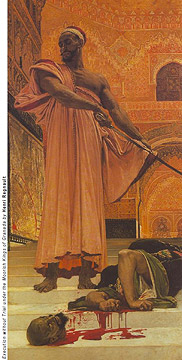Image Resource Bank
Image Gallery |  15 of 15
15 of 15 
Execution Without Trial Under the Moorish Kings of Granada
This vivid and violent image reflects European fascination with the supposed tyranny of Oriental despots. It depicts an execution where both perpetrator and victim are Moors, the European term for the Muslims who ruled Spain and North Africa in the medieval period. Granada, the kingdom referenced in the painting’s title, was the last Iberian Muslim city-state to fall to the Castilians (1492 CE), an event which marked the end of the Reconquista and the initiation of the Jewish and Muslim expulsion from Spain. We have stated elsewhere in this module that describing Middle Eastern politics and governance exclusively in terms of authoritarianism or despotism distorts a more complex historical reality, but this notion was (and continues to be) a relatively common western prejudice. For many Europeans of the nineteenth-century, Regnault’s painting captured the essence of rulership and justice in North Africa and the Middle East.
Name: Execution Without Trial Under the Moorish Kings of Granada
Material: Oil on canvas
Size: Height: 302 cm (119 in)
Width: 146 cm (57 in)
Date: 1870
Place of Origin: Granada, Spain
Location: Museé d’Orsay, Paris
Source and Registration#: Professor John E. Woods

 John Woods
John Woods
Professor of Iranian and Central Asian History, and of Near Eastern Languages & Civilizations
 Alexander Barna
Alexander Barna
Outreach Coordinator, Center for Middle Eastern Studies, University of Chicago




